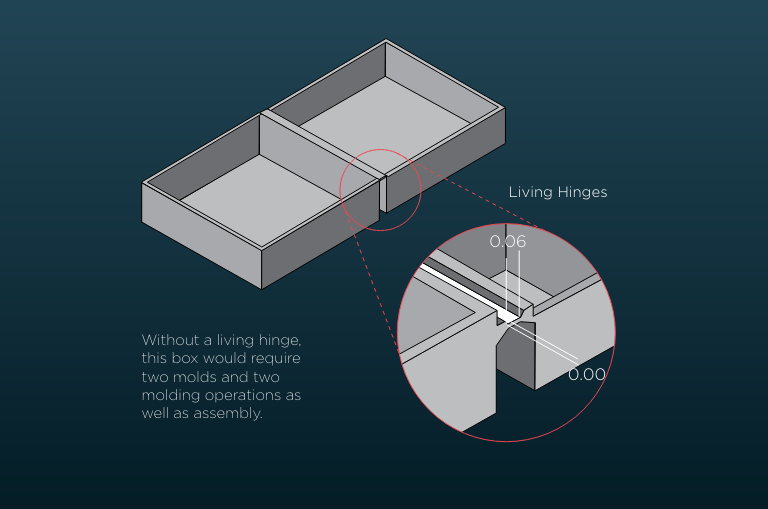
Innovation in digital manufacturing means designing products with enhanced functionalities, made cheaper and delivered faster. But innovation can also be translated right down to a part feature, like living hinges.
A living hinge is a very thin piece of plastic designed into a molded plastic part that allows for rotational movement of the part. In other words, it allows the part to fold.
Take the common plastic pill box: Without a living hinge, this product would require two molds (one of the box and one of the lid), and then two molding operations for each of the molds, and finally assembly of the two molds.
Connecting the box and the lid with a living hinge, however, allows both parts to be made as a single molded part in a single molding operation.
Living hinges are extremely commonplace in consumer products. A great example is the bottle caps on personal hygiene bottles—you’re operating a living hinge when you open and close a bottle of hand sanitizer!
Hinges are a feature that can be added into a part once it has been molded. One of our key services here at Xcentric Mold & Engineering is injection molding. Customers rely on our expert guidance in understanding when and how to add hinges to their parts post-molding, alongside other features like:
- Text or logos
- Snaps
- Threads
- Inserts
- Overmolds
- Surface finishes
Read on for our hinge design guidelines, including ways to 3D print a hinge.
Plastic Hinge vs Metal Hinge
Most living hinges are made of plastic that have a high melt flow, making them ideal for injection molding.
These plastic hinges have easily replaced metal hinges, because a part designed with molded-in hinges instead of mechanical hinges make for a better part.
While their one major limitation is that they cannot support heavy loads, the many benefits of a plastic hinge can be leveraged in both its design and function.
In the manufacturing process, a plastic hinge is often opted for to:
- Reduce the number of components within an assembly
- Reduce or eliminate the need for traditional fasteners
- Reduce material and assembly costs
- Simplify design
A plastic hinge delivers a better end-user experience because it:
- Won’t corrode or rust
- Generates little to no friction
- Is able to fold or bend up to 180 degrees
- Lasts a long time without any wear-and-tear showing
How to Design a Living Hinge
Of course, the key to unlocking the benefits of a living hinge is designing a good one. Well-designed living hinges can fold and flex repeatedly and last the life of the part without ever losing strength or flexibility.
Material selection plays a critical role in hinge design, but several other factors also influence the performance and lifespan of a living hinge.
How to Optimize Your Living Hinge Design

Common Living Hinge Designs
There are four living hinge designs common to injection molded parts:
- Straight living hinge: The most common living hinge. A flat hinge connects two sides of a part.
- Double living hinge: Two flat hinges separated by a narrow landing strip. Three flat hinges (triple living hinge) or more can also be used.
- Butterfly living hinge: A single hinge section that flips into an open or closed position. Think toothpaste tube caps!
- Bi-stable living hinge: A butterfly living hinge but with three hinge sections instead of one.
How to 3D Print a Hinge
The following 3D printing technologies can be used to make a 3D printed hinge, and are particularly suited for custom living hinge designs:
- Selective laser sintering (SLS) uses powder-based materials activated by the thermal energy of a laser
- PolyJet, where jets of liquid photopolymer are instantly cured by UV lights attached to print heads
- Multi jet fusion (MJF), where a fusing and a detailing agent are jetted to selectively melt powder particles while lamps pass over constantly to distribute heat evenly
- Stereolithography (SLA) uses a laser to harden photosensitive liquid resins
As additive manufacturing methods, they all build up the part one solid layer at a time. These methods produce a functional, smooth-surfaced 3D printed living hinge directly off the printer that requires little to no finishing or post-printing steps.
How to Design for Moldability
As useful as living hinges are, they can be difficult to mold and require careful design and gate placement.
When designing your hinges, snaps and clips, always keep in mind how the different parts are going to be assembled together into the final product.
Use mold flow analyses to pick up on areas in your living hinge design that could cause mold problems.
For the best 3D print hinge, involve an expert molding partner early on in part design, so you can receive feedback and get it to the point where it’s mold-ready.
When you work with an Xcentric engineer, we will not only work to best practices in design to ensure your part is moldable, we’ll also ensure pitfalls in design (like knit lines, sink and warps, and shrinks) are avoided. If you have a project you need help with, submit your project here and our team will be happy to provide expert advice.
About Xcentric
Founded in 1996, Xcentric Mold & Engineering is an innovator of on-demand digital manufacturing and continues to lead advances in injection molding and rapid prototyping. We know what it takes to deliver a high-quality product on time and on budget. Xcentric is engineered to be nimble, employs a team of experts in injection molding, and takes an engineer-centric approach to everything we do. Tens of thousands of product developers and engineers across North America trust Xcentric to bring their products to life.
Learn more about what Xcentric can do for you here.
Ready to submit your project? Get started here.
Questions? Contact our friendly sales team here or on 586-598-4636.
